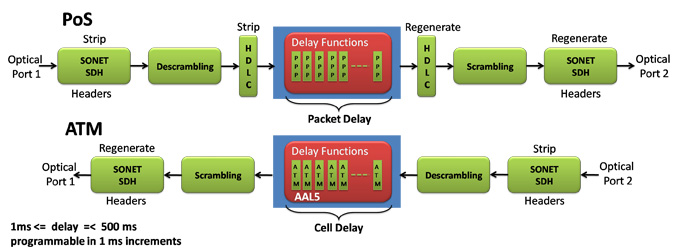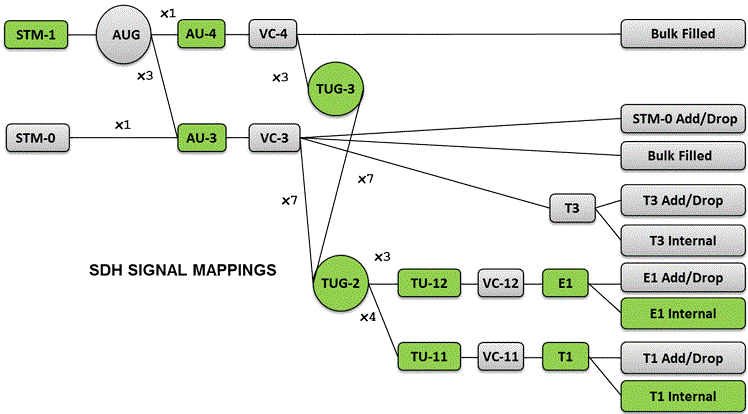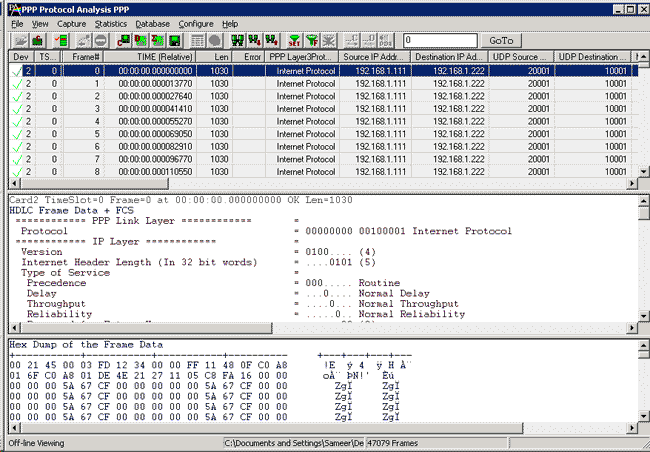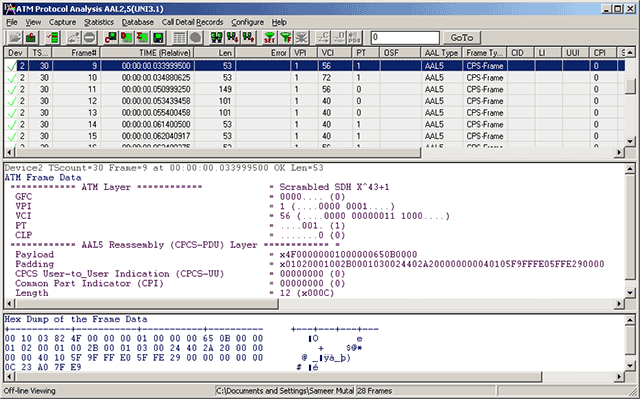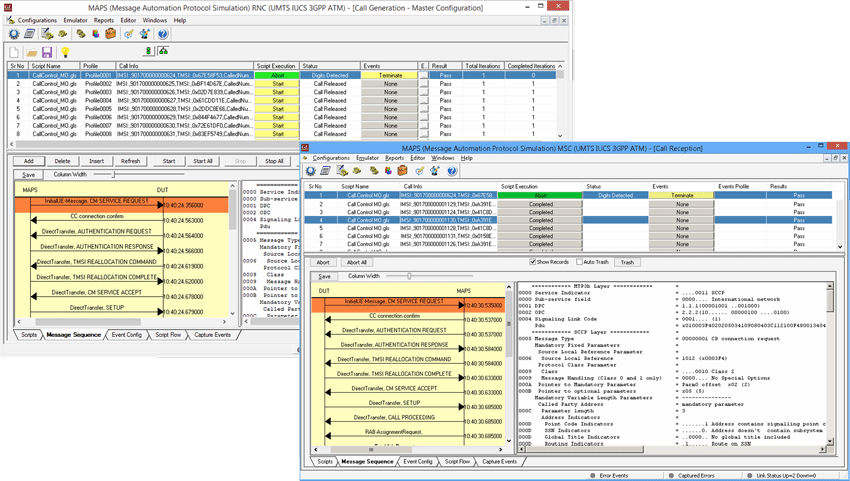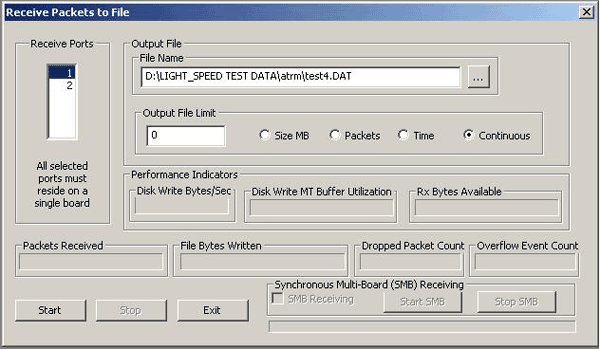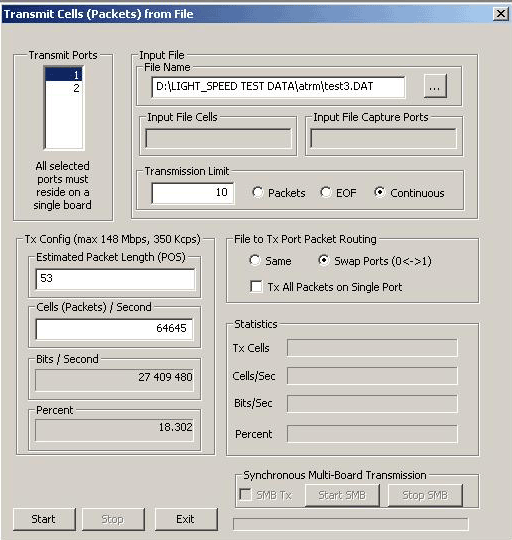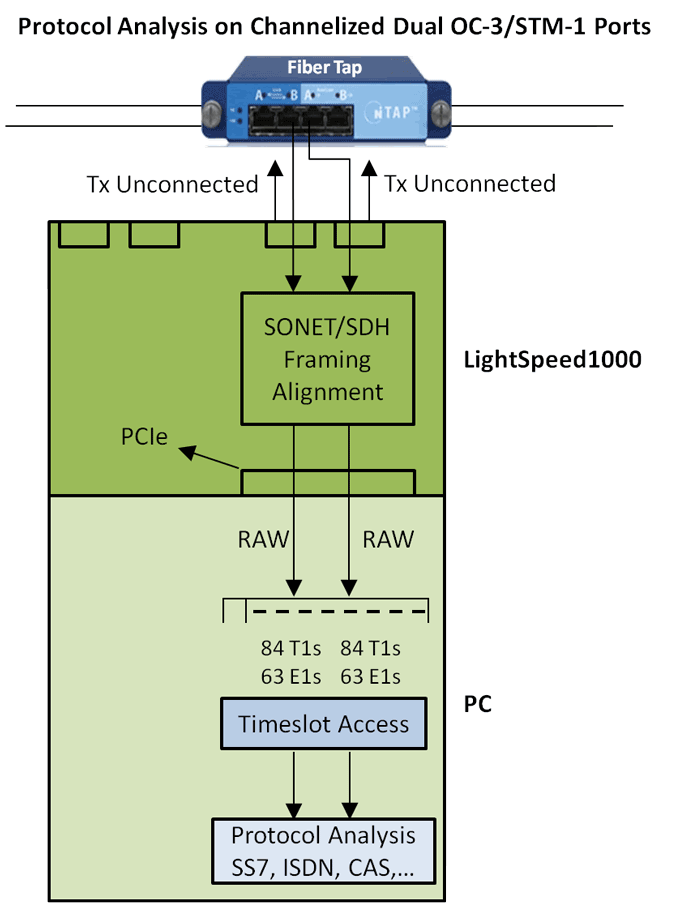Troubleshoot and Monitor Optical Links
(Channelized, and Unchannelized/Concatenated)
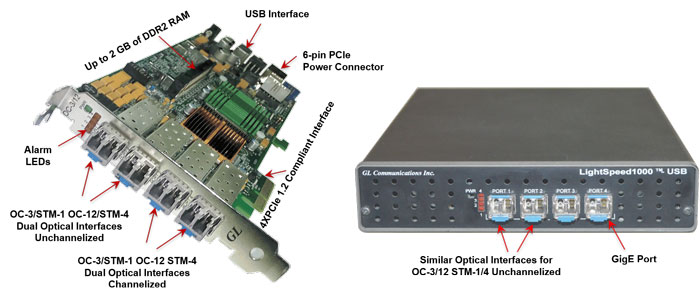
The SONET and SDH technology forms a synchronous, fiber-optic transport system and an important transmission backbone for TDM, IP, and Wireless networks. SONET is the North American standard (ANSI) based on T-carrier specifications and SDH is the similar standard used in the rest of the world (ITU). SONET uses STS-1 (Synchronous Transport Signal Level -1) as the basic level of electrically framed signal format. The optical counterpart for each STS-N signal is designated as OC-N (Optical Carrier level-N). Correspondingly, STM-N (Synchronous Transport Module Level-N) are the frame structures used in the SDH.
STM-1 and OC-3 optical transmission rates (155.52 Mbps) are the most common of the various dense pipes (in SDH SONET) carrying channelized E1, T1, E3, T3, and Ethernet multiplexed signals.
GL's LightSpeed1000™ comes with all the necessary software for overall capturing, monitoring, emulation, and protocol analysis over SONET-SDH links, with a price tag that compares very favourably with similar test instruments at 3 times the price. The LightSpeed1000™ supports both Channelized and Unchannelized mode. It is capable of wire-speed processing on quad optical ports for OC-3/OC-12 and STM-1/STM-4 lines - including Unchannelized and Channelized ATM, PoS, UMTS, and RAW Traffic. The 2 out of the quad ports are meant for SONET/SDH unchannelized and unframed data. The remaining 2 ports can be either SONET/SDH or GigE (future) ports meant for channelized data.
Packet over SONET SDH (PoS) Applications
PoS Protocol Analyzer:
Capture and analyze the packets over SONET-SDH using Point-to-Point Protocol (PPP) link layer protocol, which encapsulates other network layer protocols like IP for transmission on synchronous and asynchronous communications lines.
PoS Tx/Rx Test
:This application provides the capability of
- transmit the test packets with fixed, random, or variable lengths at a user specified data transmission rate; insert user-defined frame header in the packets transmitted
- analyze the received packets for data modifications and loss/insertion.
Wirespeed capture of PoS packets to hard disk on both ports simultaneously; with filtering and time stamping of packets.
PoS BERT:
PoS BERT Bit Error Rate Test (BERT) run over IP over PPP payload area.
- Supports the following PRBS Patterns: 29-1, 211-1, 215*-1, 220-1, 223-1, 229-1, 231-1, all one's, all zero's, alternate ones and zeros, user-defined pattern of lengths from 2 to 32 bits, invert and non-invert selections, single bit error insertion, error insert rate from 10-1 to 10-9, status for pattern sync, bit error counters, packet rate and packet gap configuration options, configurable header lengths and header information
- User-defined layer 3 header configuration supported.
- User-defined traffic rate to the accuracy of 0.001% of total bandwidth.
- Supports sequence number insertion, invert payload data, single bit error insertion, and error rate insertion
- Provides detail statistics, such as Rx/Tx packet count, bit error count, IP and UDP checksum error count
- Provides throughput details, error and alarm LEDs for easy analysis.
Channelized Mappings of OC-3/STM-1 to T1 E1 framing modes
To access and analyze channelized lines within OC-3 STM-1 can require specific and costly mux/demux hardware (perhaps at several layers) and unique test equipment. Direct access to any channel and traffic type within OC-3 STM-1 would negate the need for such additional bulky hardware and greatly simplifies testing, monitoring, and analysis cost effectively.
GL's LightSpeed1000™ in Channelized Mode provides such simplicity, permitting direct DS0 level access to hundreds of T1s and E1s, and in the near future all the E3s and T3s constituting the OC-3 and STM-1. This platform with its unique architecture eliminates the requirement for external multiplexing hardware and hundreds of cables and connectors. Multiple, independent streams of any user-defined capacity can be generated internally, analyzed, and monitored in real-time.
Channelized SONET Mapping to T1 framing modes
When configured for SONET framing mode, the LightSpeed 1000™ is capable of supporting bidirectional channelization into 84 independent T1 channels
Channelized SDH Mapping to E1 framing modes
When the LightSpeed 1000™ is configured in SDH framing mode, it is capable of supporting bidirectional channelization into 63 independent E1 channels.
Important Features
- Allows to configure the number of T1 E1 channels to be Multiplexed/Demultiplexed to / from OC-3 / STM-1
- Allows direct access to anything and everything on SONET / SDH – Framing and Payload, including structured traffic (T1, E1, STS-1, DS3 etc) or unstructured traffic (ATM, PoS, etc).
- Supports all "basic applications" and "special applications" for T1 or E1 demultiplexed channels
- Comprehensive analysis / emulation of voice, data, fax, protocol, analog, and digital signals, including echo and voice quality testing
- Supports BERT, and Capture and Playback applications
- Supports Protocol Analysis of structured protocols – HDLC, ISDN, CAS, and more.
ATM Applications
ATM Protocol Analyser:
Capture and analyze the ATM cells across the U-plane for both NNI and UNI interface carrying AAL0, AAL2 and AAL5 traffic.
ATM Tx/Rx Test:
This application provides the capability of
- transmit ATM test cells at a user specified data transmission rate; configure the ATM headers - GFC, VPI, VCI, PT, and CLP fields with the appropriate values for transmission of ATM cells; an extraneous cell can be inserted in the generated ATM cells using error insertion feature to generate a sequence error;
- analyze the received cells for data modifications and loss/insertion.
Wirespeed capture of ATM cells to hard disk on both ports simultaneously; with filtering and time stamping of packets.
ATM BERT
- supports industry standard PRBS Patterns: 29– 1, 211– 1, 215– 1, 220– 1, 223– 1, 229– 1, 231– 1, all one's, all zero's, alternate ones and zeros,
- supports user-defined pattern of lengths from 2 to 32 bits,
- invert and non-invert selections, single bit error insertion, error insert rate from 10-1 to 10-9.
- HEC error insertion, on receive filtering is provided for idle cells, GFC, VPI, VCI, CL, and PT cells,
- statistical details for total cells, valid cells, idle cells, filtered cells, and filtered out cells
Packet Delay Emulation
Packet Delay Emulator application in LightSpeed1000™ product allows users to accurately simulate network delays. User can emulate delays over live production SONET or SDH carrying ATM or PoS traffic for validating or evaluating hardware or software products under real world conditions in a controlled lab environment. It supports full duplex delay simulation for PoS and ATM based traffic from 1 ms to 500 ms, with incremental delays of 1 ms.
Typical Applications
- test the impact of delay and congestion under various real world conditions,
- assess impact of delay on SLA (Service Level Agreements),
- simulate satellite delay and long Fiber Loops
- test WAN application performance under deteriorated but repeatable conditions
UMTS Applications
UMTS Protocol Analyzer :
helps in fault diagnosis and troubleshooting UMTS network. The analyzer is capable of capturing, decoding and performing various test measurements across various Iub, Iur, IuCS and IuPS interfaces of the UMTS network. In addition, it supports ATM as the transport layer.
- Supports simultaneous decode of multiple streams of UMTS traffic on multiple OC-3 or OC-12 interfaces
- Decodes different control plane protocols i.e. NBAP, RANAP, RNSAP, ALCAP, SSCOP etc and user plane protocols i.e. Iu-UP, Iub-FP, AMR and more.
- Captures, decodes, filters, and reassembles AAL-2 and AAL-5 frames in real-time, from within the ATM cells according to user defined VPI/VCI.
UMTS IuCS Simulation:
MAPS™ IuCS ATM can emulate the RNC (Radio Network Controller) and MSC (Mobile Switching Center) nodes of the UMTs network by generating RANAP and DTAP signaling messages. The simulator uses SSCOP server that provides SSCOP, AAL5 and AAL2 layer services for establishing SSCOP links over which RANAP, ALCAP, and DTAP signaling will be carried for making calls. MAPS™ IuCS ATM internally uses AAL2 Traffic Generator for traffic generation. Various traffic types like Tone, Digits and File playback are supported.
Wirespeed Packet Capture and Playback
The software has the capability of synchronous multi-board wirespeed capture and transmission of packets to/from files. Transmit and verify data with incrementing sequence numbers.
The synchronous capture to files and synchronous transmit from files is possible simultaneously on multiple ports on multiple boards. It allows replaying the captured cell in synchronous manner to recreate the real-time traffic scenario in a lab. Synchronization within a single board on two ports is done by hardware.
Flexible DMA circular buffer architecture to read and write cells and packets at wire-speed.
